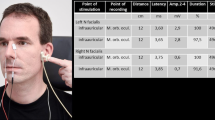Abstract
Introduction/Aims
The study aimed to visualize the changes in the facial muscles of patients with severe facial palsy who showed no improvement for more than 3 months on acute stage.
Methods
The 102 patients with severe facial palsy over House-Brackmann grade IV or an 80% degenerative ratio on ENoG at the initial examination, who showed no improvement for more than 3 months on acute stage were indicated to undergo ultrasonography of the face to evaluate the facial muscles.
Results
Muscular degeneration was observed in 537/918 muscles (58.5%). Muscle volume shrinkage was observed in 209/918 muscles (22.8%). Fascial adhesions were observed in 209/918 muscles (22.7%).
Among all the muscles assessed for degenerative changes, zygomaticus major/minor was the most affected by degenerative changes (91.2%). Degenerative changes were observed in the levator labii superioris muscle in 84.3% patients.
The shrinkage was most frequently observed in the zygomaticus major muscle (61/102 patients [59.8%]), followed by the zygomaticus minor muscle (43.1%). Shrinkage of the levator labii suprioris was observed in 24.5% patients. The zygomaticus major/minor muscle had the highest proportion of fascial adhesions in 61.8% and 66.7% patients respectively. The levator labii suprioris muscle showed the lowest proportion of fascial adhesions, with only 7.8% patients being affected.
Discussion
This study confirmed that the zygomaticus major, zygomaticus minor, and levator labii suprioris muscles, which raise the corner of the mouth, are the first to degenerate in patients with severe facial paralysis. This study demonstrated that ultrasonography is a simple and non-invasive examination for facial paralysis.









Similar content being viewed by others
References
Rosson GD, Redett RJ (2008) Facial palsy: anatomy, etiology, grading, and surgical treatment. J Reconstr Microsurg 24(6):379–389
Slade PD, Russell GF (1973) Experimental investigations of bodily perception in anorexia nervosa and obesity. Psychother Psychosom 22(2):359–363
Ho AL, Scott AM, Klassen AF, Cano SJ, Pusic AL, Van Laeken N (2012) Measuring quality of life and patient satisfaction in facial paralysis patients: a systematic review of patient-reported outcome measures. Plast Reconstr Surg 130(1):91–99
Esslen E (1973) Electrodiagnosis of facial palsy. In: Miehlke A (ed) Surgery of the Facial Nerve, 2nd edn. WB Saunders, Philadelphia, pp 45–51
Campbell ED, Hickey RP, Nixon KH, Richardson AT (1962) Value of nerve-excitability measurements in prognosis of facial palsy. Br Med J 5296:7–10
Jongkees LB (1969) Tests for facial nerve function. Arch Otolaryngol 89:127–130
Yamamoto E, Fisch U (1975) Experimentally induced facial nerve compression in cats. Acta Otolaryngol 79:390–395
Gantz BJ, Rubinstein JT, Gidley P, Woodworth GG (1999) Surgical management of Bell’s palsy. Laryngoscope 109(8):1177–1188
Yamamoto K, Kurioka T, Ohki M, Ohashi K, Harada Y, Asako Y, Sano H, Yamashita T (2022) Immune-nutritional status as a novel prognostic predictor of Bell’s palsy. Audiol Neurootol 27(5):418–426
Kokotis P, Piperos P, Zambelis T, Karandreas N (2006) Denervation pattern of three mimic muscles in Bell’s palsy. Neurophysiol Clin 36(4):255–259
Ozgur A, Semai B, Hidir UU, Mehmet Fatih O, Tayfun K, Zeki O (2010) Which electrophysiological measure is appropriate in predicting prognosis of facial paralysis? Clin Neurol Neurosurg 112(10):844–848
Dahlin LB (2006) Nerve injury and repair: from molecule to man. In: Slutsky DJ, Hentz VR (eds) Peripheral nerve surgery: practical applications in the upper extremity. Elsevier Churchill Livingston, Philadelphia, pp 1–22
Noaman HH, Shiha AE, Bahm J (2004) Oberlin’s ulnar nerve transfer to the biceps motor nerve in obstetric brachial plexus palsy: Indications, and good and bad results. Microsurgery 24(3):182–187
Takemoto N, Horii A, Sakata Y, Inohara H (2011) Prognostic factors of peripheral facial palsy: multivariate analysis followed by receiver operating characteristic and Kaplan-Meier analyses. Otol Neurotol 32(6):1031–1036
Azuma T, Nakamura K, Takahashi M, Miyoshi H, Toda N, Iwasaki H, Takeda N (2018) Electroneurography in the acute stage of facial palsy as a predictive factor for the development of facial synkinesis sequela. Auris Nasus Larynx 45(4):728–731
Nakano H, Haginomori SI, Wada SI, Ayani Y, Kawata R, Saura R (2019) Electroneurography value as an indicator of high risk for the development of moderate-to-severe synkinesis after Bell’s palsy and Ramsay Hunt syndrome. Acta Otolaryngol 139(9):823–827
Baek SH, Kim YH, Kwon YJ, Sung JH, Son MH, Lee JH, Kim BJ (2020) The utility of facial nerve ultrasonography in Bell’s palsy. Otolaryngol Head Neck Surg 162(2):186–192
Volk GF, Pohlmann M, Sauer M, Finkensieper M, Guntinas-Lichius O (2014) Quantitative ultrasonography of facial muscles in patients with chronic facial palsy. Muscle Nerve 50:358–365
Author information
Authors and Affiliations
Corresponding author
Ethics declarations
Conflict of interest
The authors declare that they have no conflict of interest.
Ethical approval
All procedures performed in studies involving human participants were in accordance with the ethical standards of the institution or practice at which the studies were conducted [The Hallym University Dong-Tan Sacred Heart Hospital institutional review board approved this retroprospective study, IRB number:2023–01-013].
Additional information
Publisher's Note
Springer Nature remains neutral with regard to jurisdictional claims in published maps and institutional affiliations.
Rights and permissions
Springer Nature or its licensor (e.g. a society or other partner) holds exclusive rights to this article under a publishing agreement with the author(s) or other rightsholder(s); author self-archiving of the accepted manuscript version of this article is solely governed by the terms of such publishing agreement and applicable law.
About this article
Cite this article
Lee, J.H., Park, IS. & Kim, J. Ultrasonographic findings of facial muscles in patients with severe facial palsy who showed no improvement for more than 3 months on acute stage. Eur Arch Otorhinolaryngol 281, 2001–2010 (2024). https://doi.org/10.1007/s00405-023-08426-7
Received:
Accepted:
Published:
Issue Date:
DOI: https://doi.org/10.1007/s00405-023-08426-7




